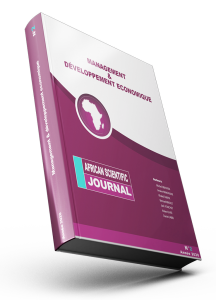Contribution to the analysis of the Moroccan dirham exchange rate volatility : Econometric modeling using the asymmetric TGARCH model
Contribution à l’analyse de la volatilité du taux de change du dirham marocain : Modélisation économétrique à l’aide du modèle asymétrique TGARCH
DOI :
https://doi.org/10.5281/zenodo.5642815Mots-clés :
Volatility, exchange rates, ARCH, asymmetric models TGARCH, Kurtosis, AKAIKE Information CritierriumRésumé
Résumé
Le contexte générale de cette étude est lié directement à la réforme du régime de change appliqué au Maroc en passant vers la flexibilité graduelle basée sur l’élargissement des bandes de fluctuation du taux de change. L’objectif principal de ce travail est de modéliser les prévisions de la volatilité des taux de change bilatéraux du dirham marocain EUR/MAD et USD/MAD tout en se basant sur la méthodologie empirique des modèles économétriques de familles ARCH. L’analyse empirique a porté sur des données allant du 30/11/2001 au 30/11/2020, avec un échantillon de 4800 observations journalières. Les résultats ont montré que la série temporelle étudiée est caractérisée par le phénomène de volatilité, par des spécifications asymétriques et l’existence d’une kurtosis excessive. Ainsi, le critère de sélection AKAIKE Information Critierrium (AIC) nous a amené à choisir le modèle asymétrique AR(1)-TGARCH comme modèle adéquat pour la modélisation et la prévision de la volatilité du taux de change du dirham marocain.
Mots clés : Volatilité, taux de change, ARCH, modèles asymétriques TGARCH, Kurtosis, AKAIKE Information Critierrium. JEL : C01, C24, C32, C58, E60, F31, F41.
Abstract The general context of this study is directly related to the reform of the exchange rate regime applied in Morocco by moving towards a gradual flexibility based on the widening of the exchange rate fluctuation bands. The objective of this work is modeling the volatility of the bilateral exchange rates of the Moroccan dirham EUR/MAD and USD/MAD while being based on the empirical methodology of the ARCH family econometric models. The empirical analysis covered a period from 30/11/2001 to 30/11/2020, with a sample of 4800 daily observations. The results showed that the time series studied is characterized by the phenomenon of volatility, asymmetric specifications and the existence of excessive kurtosis. Thus, the AKAIKE Information Critierrium (AIC) selection criterion led us to choose the asymmetric AR(1)- TGARCH model as an adequate model to forecast the volatility of the Moroccan dirham exchange rate.
Keywords : Volatility, exchange rates, ARCH, asymmetric models TGARCH, Kurtosis, AKAIKE Information Critierrium.
Téléchargements
Publiée
Comment citer
Numéro
Rubrique
Licence
(c) Tous droits réservés African Scientific Journal 2021

Ce travail est disponible sous licence Creative Commons Attribution - Pas d'Utilisation Commerciale - Pas de Modification 4.0 International.





















